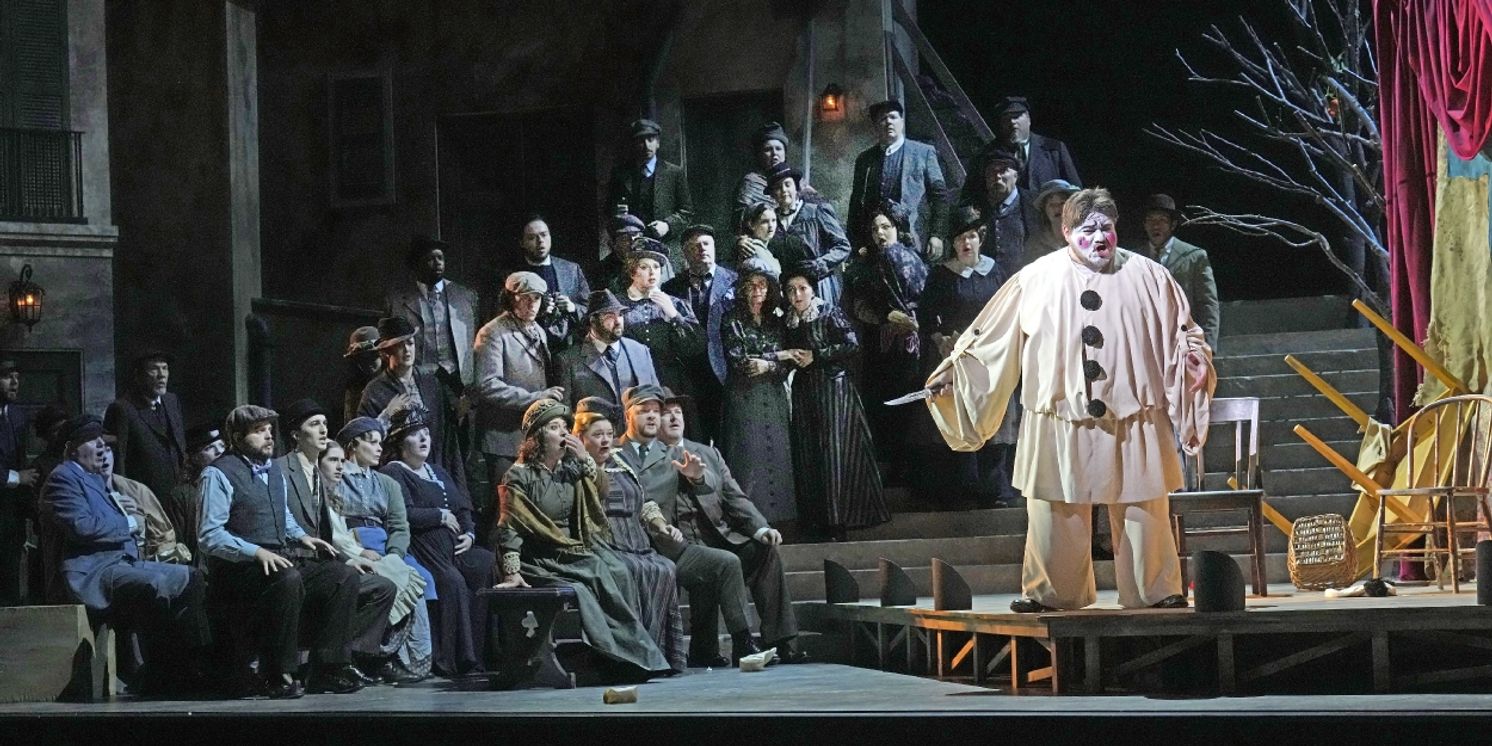Review: CAVALLERIA RUSTICANA / PAGLIACCI at Lyric
Lyric season opens with a double does of opera vérité

(Audience reacts as Canio (Diego Torre) takes method acting too far. Photo by Ken Howard)
The new season of the Lyric opened Saturday night at its usual venue the Kauffman Center for the Performing Arts. This year they have elected to start the season with a double bill: Cavallaria Rusticana and Pagliacci. Both performances were excellent and, despite some technical glitches (about which more later), on the whole it was a most satisfying evening of theater.
First, a quick word about the two performances: Cavallaria and Pagliacci (or “Cav/Pag” if you’re in a hurry) are a common double bill, often performed back to back. There are multiple reasons for this: they are both (relatively) short, may use the same sets, and are thematically similar. The main reason, however, is that they are the two best-known examples of Verismo opera. Verismo (Italian for ‘realism’) was a movement born out of an overall move to naturalism in the arts at the end of the 19th century. Instead of, e.g., magic flutes or cursed ships, the focus was on real, everyday people and the dramas they faced (film buffs who are thinking of the Italian neorealism movement are not wrong). Pietro Mascagni brought the idea to opera with his Cavallaria, and Leoncavallo was inspired by it to produce his Pagliacci. Though the movement lasted a few decades, these two have come down to us as its primary and best-known examples.
To the pieces: Cavallaria, based on a short story & play by Verga, involves the ex-soldier Turiddu (Adam Smith) who, having returned home, has discovered that his fiancee Lola (Christine Boddicker) has married his old friend Alfio (Gevorg Hakobyan, who also appears as Tonio later). To spite her, he seduces Santuzza (Samantha Hankey). It works, and Lola begins an affair with him, with Santuzza left in the lurch.
All of the above takes place beforehand, with the actual play commencing with Santuzza begging Turiddu’s mother Lucia (Jill Grove) to let her speak to Turiddu. It soon transpires he’s out with Lola again. Angered, Santuzza tells Alfio he’s being cheated on, causing him to swear vengeance. A duel is arranged, and as Santuzza listens with horror, the news comes that Alfio has slain Turiddu.
Moving on to Pagliacci, a troupe of performers comes to town. Canio (Diego Torre), the great “Pagliacco” or clown, announces a show for that evening: a comedy of marital infidelity. Little does he know his wife Nedda (Gabriella Reyes) has been carrying on with Silvio (Luke Sutliff). Troupe member Tonio, who himself is smitten with Nedda, discovers the affair, and in a fit of rage fetches Canio, who arrives too late to see Silvio’s face.
That night at the comedia, Canio cannot concentrate on his performance, brooding over his wife’s infidelity. Eventually he breaks character, demanding to know the name of her lover. Nedda tries to keep the play going, playing it off as part of the action, but it becomes increasingly obvious to all that this is real. He stabs Nedda, causing Silvio to run to her side, where he receives his own fatal blow. Canio, drained and horrified by what he has done, slumps to the floor crying out, “La commedia è finita!!”
The first thing to say is that both performances were absolutely superb. Ms. Hankey’s Santuzza was heart-wrenching, and she absolutely poured herself out on stage. Smith plays Turiddu hot and cold as needed, a man torn between honor and desire. Really the entire cast (chorus included) gave an emotionally charged performance. As to Pagliacci, much the same may be said. The principles all bring emotional depth to their characters, drawing us in and keeping their hold til the final curtain. Of especial note is of course Mr. Torre, whose “Vesti la giubba” was heartbreaking. I might also mention Ms. Reyes’ Nedda, particularly in the second act. She makes a very able clown, and watching her increasing attempts to keep the show on track as Canio gives over to rage is really something to see.
Unfortunately, not all was well with the evening. The Figaro subtitle system with which the venue is equipped was for some reason unavailable, forcing the production to use projected supertitles…which also didn’t work. Actually, they did click on about an hour into Cavalleria, but for a story which starts in medias res, a lot of important plot points would have been lost on those not already familiar with the opera. It is to the cast & crew’s credit that they carried on regardless, and the performances were strong enough to ensure viewers got the basic idea.
Finally, a word on the production itself. This is a new production, created in-house by the Lyric. It’s very well done, the staging putting this reviewer very much in mind of Positano and other such villages that stretch along the Amalfi coast. The conceit that the two stories take place a generation (and a world war) apart adds an interesting depth, though it might have been explored a bit more (somehow in 1931 Sicily there is not a whiff of fascism except a few posters on a wall). Still in all, it was a most satisfactory evening all around, and once (we trust) the technical glitches are seen too, we can recommend it unreservedly.
Reader Reviews
Videos

